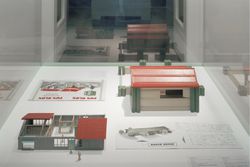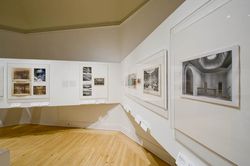Melvin Charney 1935–2012
The artist and theorist Melvin Charney, who died earlier this year, made significant contributions to the CCA and the city of Montreal as a whole. Throughout a long and varied career, Charney championed the public role of the architect in the wider built environment, enforcing the idea that the street is the primary resource of the city. The CCA is celebrating Charney’s(...)
Hall cases
24 October 2012 to 14 April 2013
Melvin Charney 1935–2012
Actions:
Description:
The artist and theorist Melvin Charney, who died earlier this year, made significant contributions to the CCA and the city of Montreal as a whole. Throughout a long and varied career, Charney championed the public role of the architect in the wider built environment, enforcing the idea that the street is the primary resource of the city. The CCA is celebrating Charney’s(...)
Hall cases
Trois Architectes, Trois Quartiers focuses on three Montréal-based architects whose work had a strong presence in a specific area of the city during the first half of the twentieth century: Ludger Lemieux (1872–1953) in St-Henri, Ernest lsbell Barott (1884–1966) in St-Antoine on the southern and western slopes of Mount Royal, and Ernest Cormier (1885–1980) at the(...)
1440 rue Sainte-Catherine Ouest
20 May 1983 to 19 August 1983
Trois architectes, trois quartiers : Ludger Lemieux (St. Henri), Ernest Cormier (Cité universitaire), Ernest Isbell Barott (St. Antoine)
Actions:
Description:
Trois Architectes, Trois Quartiers focuses on three Montréal-based architects whose work had a strong presence in a specific area of the city during the first half of the twentieth century: Ludger Lemieux (1872–1953) in St-Henri, Ernest lsbell Barott (1884–1966) in St-Antoine on the southern and western slopes of Mount Royal, and Ernest Cormier (1885–1980) at the(...)
1440 rue Sainte-Catherine Ouest
During the eighteenth century, Rome was both an important centre for Italian art and the focal point for the studies of most European artists; all were drawn by the city’s antique art, architecture, and statuary, as well as its Renaissance, Baroque, and eighteenth-century masterpieces. Exploring Rome: Piranesi and His Contemporaries is concerned with eighteenth-century(...)
Main galleries
18 August 1993 to 2 January 1994
Exploring Rome: Piranesi and His Contemporaries
Actions:
Description:
During the eighteenth century, Rome was both an important centre for Italian art and the focal point for the studies of most European artists; all were drawn by the city’s antique art, architecture, and statuary, as well as its Renaissance, Baroque, and eighteenth-century masterpieces. Exploring Rome: Piranesi and His Contemporaries is concerned with eighteenth-century(...)
Main galleries
Dream Houses, Toy Homes
Through selections from the CCA’s collection of architectural toys and games, including 33 European and North American architectural toys dating from the early nineteenth century to 1995, Dream Houses, Toy Homes examines the notions of home, childhood, play, gender, and learning. The exhibition uncovers the potential of toys to embody images and ideas of domestic(...)
Dream Houses, Toy Homes
Actions:
Description:
Through selections from the CCA’s collection of architectural toys and games, including 33 European and North American architectural toys dating from the early nineteenth century to 1995, Dream Houses, Toy Homes examines the notions of home, childhood, play, gender, and learning. The exhibition uncovers the potential of toys to embody images and ideas of domestic(...)
Toys that Teach
The architectural toy typically looks to the world of “real” buildings, reproducing columns, arches, and windows in miniature form. Toys That Teach, however, presents a range of construction toys based on the elementary forms of geometry found in nature: cubes and spheres, cones and cylinders, rods and prisms. The toys serve not only for building but also for mathematical(...)
Octagonal gallery
16 December 1992 to 25 April 1993
Toys that Teach
Actions:
Description:
The architectural toy typically looks to the world of “real” buildings, reproducing columns, arches, and windows in miniature form. Toys That Teach, however, presents a range of construction toys based on the elementary forms of geometry found in nature: cubes and spheres, cones and cylinders, rods and prisms. The toys serve not only for building but also for mathematical(...)
Octagonal gallery
Toplight: Roof Transparencies from 1760 to 1960 traces the evolution of skylights from their origins at the end of the eighteenth century, when this type of fenestration was first explored in Paris’s new Halle au blé (1763–1782), to James Stirling’s History Faculty Building, University of Cambridge (1963–1968). The exhibition is organized around a series of case studies(...)
Octagonal gallery
23 October 2008 to 15 February 2009
Toplight: Roof Transparencies from 1760 to 1960
Actions:
Description:
Toplight: Roof Transparencies from 1760 to 1960 traces the evolution of skylights from their origins at the end of the eighteenth century, when this type of fenestration was first explored in Paris’s new Halle au blé (1763–1782), to James Stirling’s History Faculty Building, University of Cambridge (1963–1968). The exhibition is organized around a series of case studies(...)
Octagonal gallery
The Idea of the Penitentiary
This exhibition explores the notion of penitentiary, which worked its way into the consciousness and across the landscape of Europe and North America during the nineteenth century. Drawing upon the growing rationalist tendencies in architecture and social theory during the eighteenth century, proponents of penitentiary emphasised a clear geometry of separation,(...)
Hall cases
8 November 1995 to 31 May 1996
The Idea of the Penitentiary
Actions:
Description:
This exhibition explores the notion of penitentiary, which worked its way into the consciousness and across the landscape of Europe and North America during the nineteenth century. Drawing upon the growing rationalist tendencies in architecture and social theory during the eighteenth century, proponents of penitentiary emphasised a clear geometry of separation,(...)
Hall cases
Technological advances as well as the general social, political, and economic climate have always been of great interest to architects. Toys and the Modernist Tradition examines at how toy manufacturers responded to the exciting and rapidly changing ideas of modern architects. Many of the exhibited toys were designed by leading architects of the modern movement, including(...)
Toys and the Modernist Tradition
Actions:
Description:
Technological advances as well as the general social, political, and economic climate have always been of great interest to architects. Toys and the Modernist Tradition examines at how toy manufacturers responded to the exciting and rapidly changing ideas of modern architects. Many of the exhibited toys were designed by leading architects of the modern movement, including(...)
Kids Build
Pulling from the extensive collection of architectural toys and games at the CCA, Kids Build presents examples of the many ways that architectural space is rendered through toys, as well as playful explorations of the relationships between basic elements and the architectural worlds they generate. It also suggests that as toys represent architectural ideas, they(...)
Hall cases
9 December 2015 to 24 April 2016
Kids Build
Actions:
Description:
Pulling from the extensive collection of architectural toys and games at the CCA, Kids Build presents examples of the many ways that architectural space is rendered through toys, as well as playful explorations of the relationships between basic elements and the architectural worlds they generate. It also suggests that as toys represent architectural ideas, they(...)
Hall cases
The exhibition presents three aspects of the villas described by the Roman writer, Pliny the Younger, in the first century AD: their direct historical influence on architecture, the indirect influence they have exerted on architects as a model for study, and their impact on the classical tradition in the city of Montreal. The Villas of Pliny and Classical Architecture(...)
Musée des beaux-arts de Montréal
14 October 1983 to 11 December 1983
The Villas of Pliny and Classical Architecture in Montréal
Actions:
Description:
The exhibition presents three aspects of the villas described by the Roman writer, Pliny the Younger, in the first century AD: their direct historical influence on architecture, the indirect influence they have exerted on architects as a model for study, and their impact on the classical tradition in the city of Montreal. The Villas of Pliny and Classical Architecture(...)
Musée des beaux-arts de Montréal









